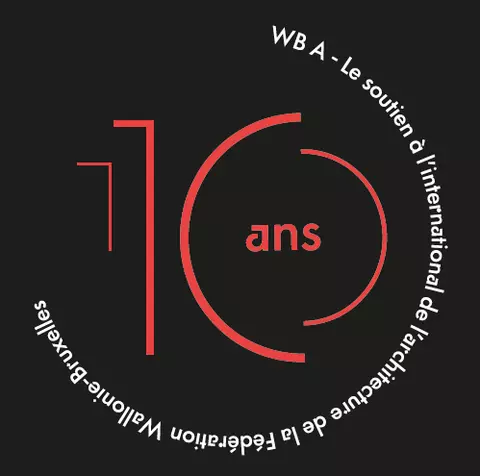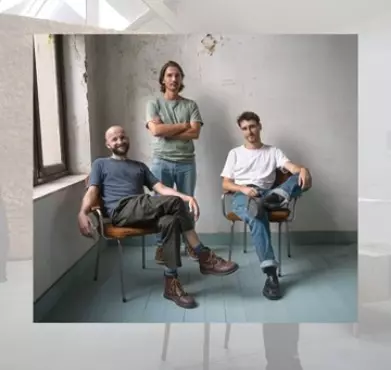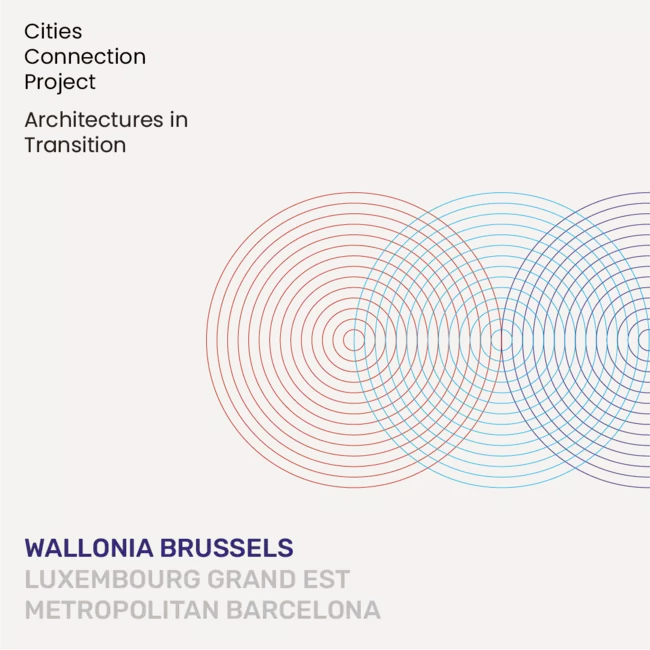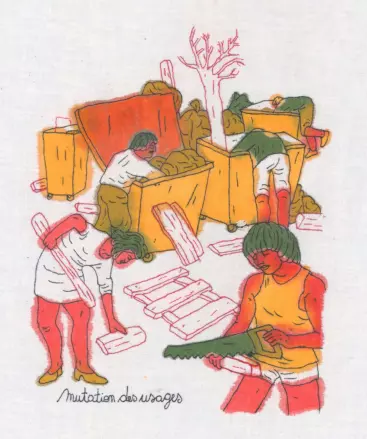- actionsDate de l'événement
26/04/2020Site Internet
Published on 26/04/2020
WBA celebrates its 10th anniversary!
Image CopyrightEKTA
CopyrightEKTAOn April 26 2020, WBA celebrated its 10th anniversary. The opportunity to look back on the creation of the agency, its missions and projects through excerpts from the interview with Nathalie Brison, project manager at WBA, conducted by Déborah Lévy and Antoine Wang as part of the creation of the agency's new brochure - which was designed by the graphic studio EKTA.
The agency Wallonie-Bruxelles Architectures (WBA) was founded in 2010. How did it happen?
Before the creation of WBA, a series of small organisations were already working to spread the influence and export the cultural and creative industries of Federation Wallonia-Brussels (FWB). These agencies still exist and deal with music (WBM), theatre and dance (WBTD), image (WBImages) and fashion and design (WBDM). After the publication of the Livre blanc de l’architecture contemporaine en Communauté française de Belgique (White paper on contemporary architecture in the French Community of Belgium)(2004), the creation of the Architecture Unit (2007) and the dynamic that was thus established, architecture began to find its place among the institutions. In this context, WBA was founded. First of all this would acknowledge the quality of architectural production in FWB, which deserved to be given visibility abroad. Then, it would respond to architects’ true desire to initiate meetings and collaborations based on which they could develop their practice abroad. Finally, the aim was to stabilise and consolidate international initiatives initiated by the Architecture Unit with the occasional support of the FWB ‘foreign affairs department’, which is known today by the acronym WBI (Wallonie-Bruxelles International).
(…)
You are canvassing in very different geographical areas. How do you choose them?
The French market is an intuitive choice for several reasons. There is of course the shared language, quite a similar culture and the proximity. In the same way, other French-speaking countries, such as Switzerland and Canada, have offered us opportunities to organise exhibitions and conferences.
Then, the countries to canvas must meet a series of criteria. A market that is sufficiently open and a growing economy are a favourable context for architects who would like to export their work. There are also feasibility criteria: convincing canvassing, a solid local team or contacts to work with, etc. And then, there is the question of cultural influence with cities like London, where it is quite difficult to make a name, but which give incredible visibility.
In addition to the strategy, it’s also a question of opportunities to be seized. The Cities Connection Project Wallonia-Brussels/Barcelona1, for example, which is curated by Nicola Regusci and Xavier Bustos Serrat arose from a meeting. In 2016, when the exhibition entrer: cinq architectures en Belgique was shown at the Geneva ‘Quinzaine de l’urbanisme et du territoire’, it was placed alongside other exhibitions, including a previous version of Cities Connection Project. Two years later in 2018, discussions with the curators and the interest of the concept led us to create this new touring exhibition (Brussels in 2018; Barcelona, Tarragona and Lugano in 2019) which highlights 20 projects designed by FWB architects and 20 Spanish projects surrounding the theme of the reuse of existing space and the mixed use and reconstruction of the city.
Each meeting with an institution offers us an opportunity to develop long-term relationships. Maintaining contacts with motivated and dynamic partners, to avoid ‘one-shots’, also enables us to consolidate networks and share debates on questions that involve the sector, beyond the simple question of opportunities to access orders.
And then, we also work with a series of Belgian institutional partners. Our preferred partner is the Architecture Unit, with whom we collaborate on many projects. It provides us with content that we then disseminate abroad.
What are the main tools you have to spread architectural practices?
One of the main vectors is exhibitions. Their presentation is generally the ‘pretext’ for developing a comprehensive activity programme (conferences, press meeting, building tour, etc.).
We create these exhibitions, which is the case of the exhibition entrer: cinq architectures en Belgique2 that was curated by Audrey Contesse. It presents five recent buildings, which reflect the diversity of contemporary architectural production in Wallonia and Brussels, to be discovered along a sound and visual walk. These buildings — within the city or outside it, and mainly public facilities — demonstrate all the projects undertaken by architects and their backers, with the desire to dedicate architecture to a better quality of life for citizens. Five buildings that change use and experience: urban conquest by the conversion of industrial land to mixed cultural and commercial use, the renovation of heritage for a historical project with works of art, metamorphosis of a public space, sports facility in osmosis with the landscape in an outstanding setting and finally a private order for a small building to house and showcase the works of a collector. This exhibition was shown in Paris (2015), Geneva (2016), London (2017) and Montreal (2018).
We are also working on touring exhibitions created by our institutional partners. I can mention, for example, the exhibition Inventaires #2. This exhibition was designed in support of the publication Architectures Wallonie-Bruxelles Inventaires #2 Inventories3 created by the Architecture Unit and WBA under the scientific management of Xavier Lelion and Anne Sophie Nottebaert. This work represents the third volume of the collection initiated in 2010 whose aim is to create a portrait of recent architecture in Wallonia and Brussels every three years. The exhibition is a review of censuses, investigations, and writing work done for the eponymous publication. It sets out to analyse 28 projects through the interpretation of 25 authors from different media: writing, drawing, cartoons, and photographs. It was presented in London in 2017, in Nantes in 2018 and in Bucharest in 2019.
In 2019 WBA developed new tools. What are they? What have they made possible?
The new tools arose from a discussion organised at the round table Freespace et frontières on 25 May 2018 at the Belgian Pavilion for the Venice Biennale. FWB architects spoke freely about the different types of support they feel they need to develop their activity abroad in a more free-flowing and structured way.
What emerged from these discussions is that they lack promotional tools to present themselves effectively on the international scene. Two aids have been put in place: on the one hand a subsidy for the production of a communication tool about their work, for example a brochure, and on the other hand, support for the creation of mediation materials, such as creating a mock-up for an exhibition. Architects who have already received this support confirm the relevance of this type of ‘leg up’, as the materials produced within this framework can be reused elsewhere. For example, the brochure photos can illustrate their website and the texts can be used for competition entry.
The second point that emerged from our discussions was the obstacle language is to entering for international prizes. To avoid the costs of translation, which are too onerous for small organisations, being an obstacle, we have created a translation subsidy. It may be requested to enter an international prize, such as the Mies Van Der Rohe prize or the European Landscape Prize, when a dossier needs to be drafted in English or another language than French, but not to enter a tender for a public contract.
(…)
What is the least visible part of WBA’s work?
What one needs to understand, is that each year, WBA creates a programme virtually from nothing. Most of the other FWB export agencies are organised around a calendar of essential events. We cannot, as is done in other sectors, book our ‘stand’ at a trade fair each year... There is therefore a considerable amount of canvassing to be done to meet potential partners abroad. There is an entire set of background work that has to be assessed over the long term.
As architects sell their services, and not products that can be duplicated, it requires significant mediation which involves developing a pitch (hence conferences and publications) and using demanding scenographic resources (exhibitions, films, photo reports, etc.). There is therefore administrative and logistical work that is not necessarily visible, but which is essential.
And then there’s the importance of social networks and our communication work. We disseminate information via Facebook, on our website and via our bilingual newsletter. It’s daily work that requires a lot of monitoring, but the results are there. International journalists tell us that they regularly use our datasheets on architects’ firms to find out about their new projects.
(…)
- actionsDate de l'événement
5/12/2024Published on 28/10/2024
-
A vos agendas ! Cities Connection Project #7 à Bruxelles
Nous avons le plaisir de vous convier au vernissage de l’exposition Cities Connection Project qui aura lieu le 5 décembre 2024 à 20h30 à la Faculté d [...]
- actionsDate de l'événement
20 - 30/11/2024Published on 28/10/2024
-
Inventaires#4 à Paris
Nous avons le plaisir de vous inviter à la présentation de l'ouvrage Architectures Wallonie-Bruxelles Inventaires #4, Vers une démarche architecturale [...]




